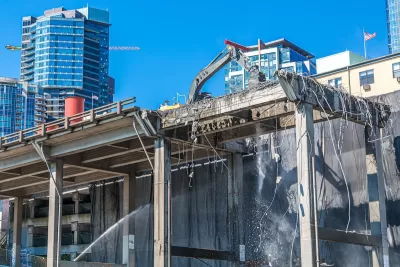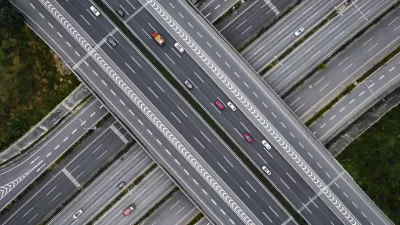Resistance from state transportation departments and precarious funding sources mean highway removal projects are few and far between, despite their benefits.

Highway removal: why isn’t it happening in more places? Joe Harrington poses this question in Next City, noting that “The benefits [of removal] for the communities living along highways are obvious: People have experienced health, environmental, economic and mobility harms for the last 70 years. Communities originally displaced lost billions in generational wealth opportunities in the ensuing displacement and residents today continue to bear harm.”
Harrington lists several reasons that highway removal is not more popular yet. These include “sluggish policy responses” at the federal level that have failed to keep up with the data. Even the Reconnecting Communities program, which is specifically aimed at removing highways, has not resulted in many actual removals. According to Harrington, “There’s an urgent need for federal guidance to leverage successful highway removal initiatives, enabling more cities to pursue this transformative approach.”
Highway removal projects are also stymied by an outdated mindset pervasive in state transportation departments. “Their entrenched traffic engineering mindsets, earmarked funding and institutional resistance to change impede efforts to promote alternatives to highways, from Minnesota to Texas.”
For Harrington, “Current procedures and technical practices—built by and for highway projects—need to shift as we focus on restoring divided neighborhoods, advancing our climate resilience and creating equitable cities.”
FULL STORY: It’s time to start removing highways. For real this time

Maui's Vacation Rental Debate Turns Ugly
Verbal attacks, misinformation campaigns and fistfights plague a high-stakes debate to convert thousands of vacation rentals into long-term housing.

Planetizen Federal Action Tracker
A weekly monitor of how Trump’s orders and actions are impacting planners and planning in America.

In Urban Planning, AI Prompting Could be the New Design Thinking
Creativity has long been key to great urban design. What if we see AI as our new creative partner?

Congress Kills Office Conversion Tax Credit
A federal tax incentive for energy efficiency upgrades is going away next year.

How the ‘Big Beautiful Bill’ Impacts Transportation
Five ways the bill negatively impacts U.S. transportation policy.

California Creates Housing-Focused Agency
Previously, the state’s housing and homelessness programs fell under a grabbag department that also regulates the alcohol industry, car mechanics, and horse racing.
Urban Design for Planners 1: Software Tools
This six-course series explores essential urban design concepts using open source software and equips planners with the tools they need to participate fully in the urban design process.
Planning for Universal Design
Learn the tools for implementing Universal Design in planning regulations.
planning NEXT
Appalachian Highlands Housing Partners
Mpact (founded as Rail~Volution)
City of Camden Redevelopment Agency
City of Astoria
City of Portland
City of Laramie





























